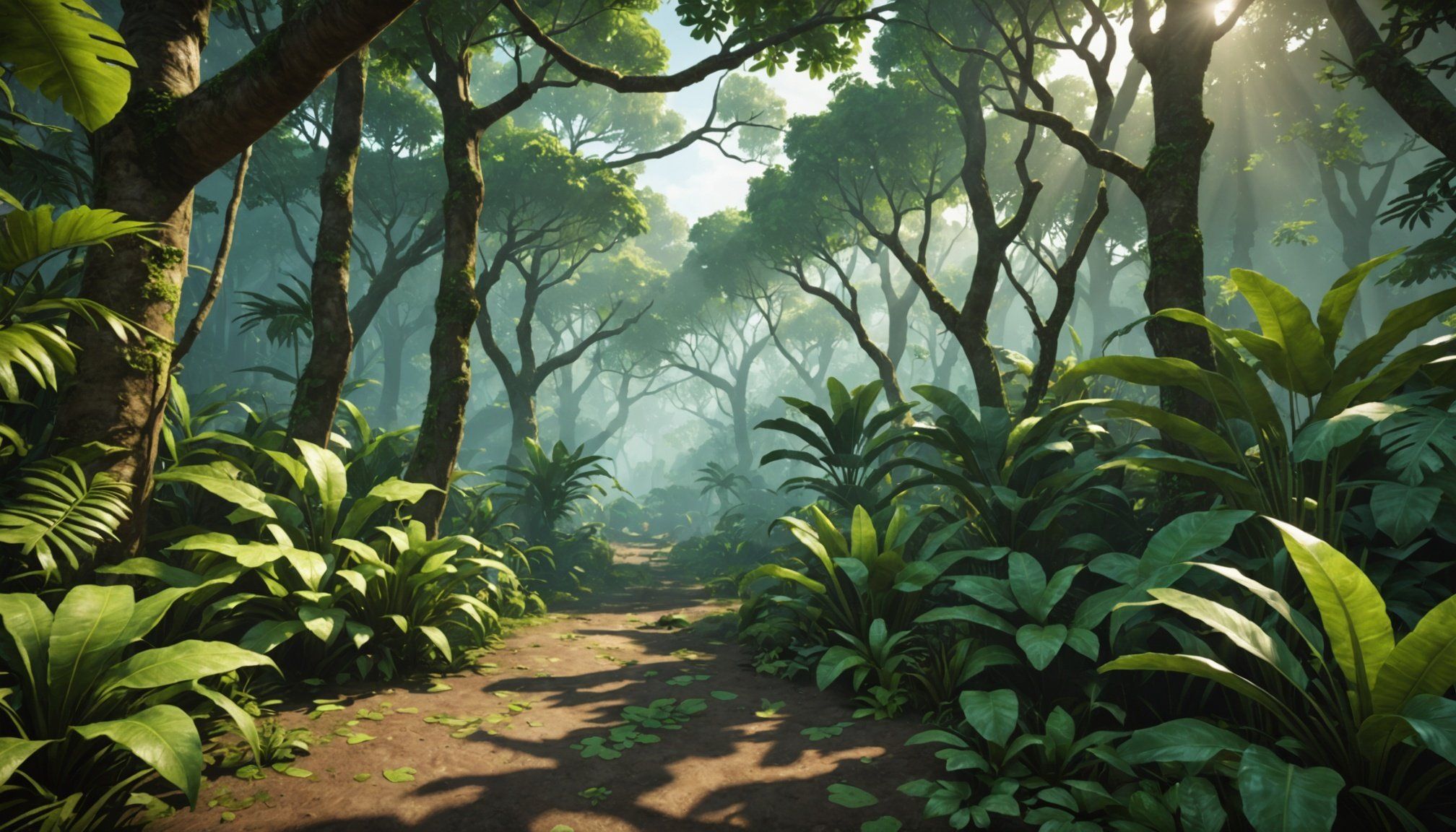Designing Realistic Jungle Environments
Creating a highly realistic jungle environment hinges on interactive jungle design that captivates users through authentic visuals and experiences. An essential aspect of this is the representation of authentic vegetation, which portrays the lush, untamed essence of a true jungle. This involves using diverse plant species that mirror their real-life counterparts, providing both visual and biological accuracy.
To achieve environmental realism, employing advanced techniques for rendering realistic textures and colors is vital. This includes utilizing high-resolution textures that reflect the intricate details of leaves, branches, and bark. Colors should accurately depict the vibrant greens and browns found in nature, influenced by different lighting conditions that vary throughout the day.
Also read : Mastering realistic cloudscapes: key ingredients for flight simulation excellence
One effective method to enhance realism is by layering plant species to create depth and variety. This approach not only adds visual complexity but also mirrors natural growth patterns where multiple layers of flora coexist. By strategically placing ground cover, shrubs, and towering trees, designers can form immersive settings that engage users, drawing them into the simulated wilderness.
These elements collectively contribute to crafting an interactive jungle environment that prioritizes authenticity, immerses audiences, and meets the growing demand for immersive settings in digital landscapes.
Also to read : Mastering intuitive hud design in fps games: key elements for an engaging user experience
Strategies for Interactive Vegetation
Creating immersive environments in gaming is highly dependent on the interactive mechanics that developers employ. Responsive foliage movement, for instance, is a key game design technique that can significantly enhance player engagement. By simulating the subtle rustle of leaves or the bending of branches as players move through an environment, games can create a sense of realism and responsiveness.
Additionally, utilizing triggers for player interactions with plants provides a direct way for players to engage with the environment. Triggers can activate specific plant reactions, such as releasing seeds or changing colour, based on the player’s actions. This approach not only heightens the level of interactivity but also intrigues the player to explore further.
Lastly, establishing dynamic ecosystems that react to player actions brings an added layer of complexity to the game’s world. Such ecosystems can evolve over time or alter in response to player decisions, creating a living, breathing environment. These elements work together to provide a captivating game experience, using advanced game design techniques to support player interaction and engagement.
Environmental Storytelling through Vegetation
In the world of narrative design, vegetation plays a crucial role in immersive storytelling. By carefully integrating environmental cues, developers can convey complex cultural and historical narratives. For instance, an ancient forest might whisper tales of bygone civilizations through its overgrown ruins and select plant species, creating a rich tapestry of world-building.
Designing flora to mirror gameplay challenges or story arcs is an innovative approach. Thorny bushes, for example, not only serve as physical obstacles but also symbolize a character’s turbulent journey. Similarly, blossoming meadows could reflect moments of peace and triumph, guiding players emotionally through the story.
Additionally, the incorporation of hidden elements within foliage encourages exploration and discovery. Players may stumble upon hidden paths, secret messages, or treasures cleverly tucked away in dense vegetation. This not only enriches the player’s experience but also rewards the attentive observer, fostering a deeper connection to the game’s universe.
By using environmental cues like vegetation, game designers can create immersive storytelling experiences that captivate players and enhance the depth of game narratives. Such elements serve to bridge the gap between the player and the virtual world, making the interaction more meaningful and engaging.
Tool Recommendations for Vegetation Design
Integrating realistic vegetation into game environments requires selecting game development tools designed for this purpose. Game engines like Unity and Unreal Engine are popular choices due to their robust vegetation toolsets. Unity offers resources like Terrain and SpeedTree, enabling developers to create dynamic landscapes. Unreal Engine’s Landscape and Foliage tools are widely appreciated for their high-fidelity vegetation rendering capabilities.
For rapid vegetation design, plugins and assets are invaluable. Unity developers often turn to the Vegetation Studio Pro plugin, which provides advanced terrain details and supports large ecosystems efficiently. Similarly, Unreal Engine users benefit from assets like the Megascans library, offering ultra-realistic vegetation elements.
Successful game case studies illustrate the effectiveness of these software recommendations. For instance, the game “The Witcher 3” utilized SpeedTree for its rich and expansive forests, enhancing the player’s immersive experience. Similarly, “Horizon Zero Dawn” leveraged the power of Unity’s terrain system to craft its lush, post-apocalyptic landscapes.
Considering these design resources can significantly streamline the vegetation design process and elevate the visual narrative of any game world.
Visual Examples and Case Studies
Exploring the intersection of game analysis and visual design, this section delves into how successful games craft immersive experiences. Engaging with case studies and visual references offers valuable insights into creating compelling environments.
Case Study: Notable Exploration Games
In examining notable exploration titles, certain games stand out for their exemplary design techniques. For instance, the acclaimed game “Journey” beautifully melds minimalist art with expansive deserts, creating an atmosphere of awe and solitude. Such games illustrate how visual references can enhance narrative depth.
Breakdown of Effective Jungle Environments
Creating an effective jungle environment involves strategic use of visual references and layered soundscapes. Successful designs, like those seen in “Uncharted,” utilize lush foliage and dynamic lighting to simulate a vibrant ecosystem, engaging players at every turn. Understanding these elements is paramount for designing immersive gaming worlds.
Visual References for Inspiration
Visual inspiration is vital for developing unique art styles. By analyzing specific titles, game designers can distill key elements from different art styles. The lush and vibrant visuals of “Ori and the Blind Forest” exemplify how diverse palettes and intricate backgrounds can create a sense of wonder, guiding players through a captivating jungle exploration experience.
Enhancing Player Immersion and Engagement
Achieving a remarkable player experience requires a focus on techniques that amplify immersion. Soundscapes, carefully designed to complement different types of vegetation, play a crucial role. Subtle environmental sounds can give players the feeling of being within the game world, enhancing gameplay mechanics further. Imagine footsteps muffled by grass or echoes in a cavern – these auditory cues enrich the virtual environment.
Sightlines and visual pathways are equally significant. Well-crafted visual cues guide players intuitively through the game, maintaining engagement and ensuring seamless exploration. Varied sightlines prevent monotony, keeping the player curious and attentive. Gameplay mechanics become more engaging when exploration elements are dynamically integrated, rewarding players for their curiosity.
Strategies for sustaining engagement also include integrating exploration elements that challenge but don’t frustrate. Introduce hidden paths, secret areas, or interactive elements that ignite a sense of discovery. These strategies not only enhance immersion techniques but also foster a deeper connection with the game world. Players are encouraged to explore, discover, and engage actively, making the gaming experience more rewarding and memorable.











